Research Paper
- An, J.M., Lee, H.J., Park, I.S., Kim, K.H. and Choi, S.I., 2010, “A study of Fe removal efficiency of acid mine drainage by physico-chemical treatment,” Journal of The Korean Society for Geosystem Engineering, Vol. 47, No. 4, pp. 530-538.
- An, J.M., Yim, G.J., Jung, J.W., Ji, S.W., Chenong, Y.W., Park, H.S. and Choi, S.I., 2011. “Applicable effectiveness of organic mixtures for treatment of acid mine drainage in SAPS,” Journal of The Korean Society for Geosystem Engineering, Vol. 48, No. 1, pp. 34-44.
- Boyle, E.A., Edmond, J.M. and Sholkovitz, E.R., 1977, “The mechanisms of iron removal in estuaries,” Geochimica et Cosmochimica Acta., Vol. 41, No 9, pp. 1313-1324.
- Broshears, R.E., Runkel, R.L., Kimball, B.A., Mcknight, D.M. and Bencala, K.E., 1996, “Reactive solute transport in an acidic stream: Experimental pH increase and Simulation of contraols on pH, Sluminum, and Iron,” Environmental Science and Technology, Vol. 30, No. 10, pp. 3016-3024.
- Bullen, T.D., Krabbenhoft, D.P. and Kendall, C., 1996, “Kinetic and mineralogic controls on the evolution of groundwater chemistry and 87Sr/86Sr in a sandy silicate aquifer, northern wisconsin, USA,” Geochimica et Cosmochimica Acta., Vol. 60, No. 10, pp. 1807-1821.
- Cheong, Y.W., Min, J.S., Lee, H.J. and Kwon, K.W., 1997, “A treatment of acid mine drainage using the rice stalk and cow manure,” Journal of the Korean Society of Groundwater Environment, Vol. 4, No. 3, pp. 116-121.
- Choo, C.O., Jeong, G.C. and Lee, J. K., 2007, “Characteristics of the Dalseong acid mine drainage and the role of schwertmannite,” The Korean Journal of Engineering Geology, Vol. 17, No. 2, pp. 187-196.
- Hans, C.C., 1983, “Sources and mechanisms of recharge for ground water in the west-central amargosa desert, Nevada-a geochemical interpretation,” U.S. Geological Survey, pp. 83-542.
- Jeong, G.Y. and Lee, B.Y., 2003, “Secondary mineralogy and microtextures of weathered sulfides and manganoan carbonates in mine waste-rock dumps, with implications for heavy-metal fixation,” American Mineralogist, Vol. 88, pp. 1933-1942.
- Jung, M.C. and Jung, M.Y., 2006, “Evaluation and management method of environmental contamination from abandoned metal mines in Korea,” Journal of The Korean Society for Geosystem Engineering, Vol. 43, No. 5, pp. 383-394.
- Kim, A.Y., Ko, M.S., Kim, J.Y., Kim, K.W., Bang, S., Sim, Y. and Park, H.S., 2011, “Removal technology for arsenic in mine drainage with the consideration of its geochemical characteristics,” Journal of The Korean Society for Geosystem Engineering, Vol. 48, No. 2, pp. 145-154.
- Kim, D.H., 2005, “Then main contents of mine pollution prevention and reclamation law,” Journal of The Korean Society for Geosystem Engineering, Vol. 43, No. 1, pp. 91-96.
- Kim, G.M., Kim, D.H. and Baek, H., 2012, “Evaluation of rice wine waste as substrate for use in acid mine drainage treatment,” Journal of The Korean Society for Geosystem Engineering, Vol. 49, No. 1, pp. 18-25.
- Kim, J.Y., Chon, H.T. and Jung, M.C., 1999, “Assessment of applicability of marine shells as neutralizer for the treatment of acid mine drainage,” Journal of The Korean Society for Geosystem Engineering, Vol. 36, No. 5, pp. 319-327.
- Kimball, B.A. and Runkel, R.L., 2010, “Evaluating remediation alternatives for mine drainage, Little Cottonwood Creek, Utah, USA,” Environmental Earth Sciences, Vol. 60, pp. 1021-1036.
- Lee, J.E., Kim, Y. and Choo, C.O., 2003, “Hydrogeochemistry and comparison of leachate and effluent from the Dalsung mine,” Journal of the Geological Society of Korea, Vol. 39, No. 4, pp. 519-533.
- Liu, Y.G., Zhou, M., Zeng, G.M., Li, X., Xu, W.H. and Fan, T., 2007, “Effect of solids concentration on removal of heavy metals from mine tailings via bioleaching,” Journal of Hazardous Materials, Vol. 141, No. 1, 202-208.
- Maurice, R.J., 1981, “Discussion of trace metals in the waters of a partially-mixed estuary,” Estuarine, Coastal and Shelf Science, Vol. 12, No. 3, pp. 251-266.
- Morin, G. and Calas, G., 2006, “Arsenic in soils, mine tailings, and former industrial sites,” Elements, Vol. 2, 97-101.
- Rodríguez, L., Ruiz, E., Alonso, A.J. and Rincón, J., 2009, “Heavy metal distribution and chemical speciation in tailings and soils around a Pb-Zn mine in Spain,” Journal of Environmental Management, Vol. 90, No. 2, pp. 1106-1116.
- Runkel, R.L., Kimball, B.A., Walton-day, K., Verplanck, P.L. and Broshears, R.E., 2012, “Evaluating remedial alternatives for an acid mine drainage stream: a model post audit,” Environmental Science and Technology, Vol. 46, pp. 340-347.
- Smedley, P.L. and Kinniburgh, D.G., 2002, “A review of the source, behaviour and distribution of arsenic in natural waters,” Applied Geochemistry, Vol. 17, No. 5, pp. 517-568.
- Ure, A.M., 1995, Method of analysis for heavy metals in soils, 2nd Ed., Chapman and Hall, Glasgow, pp. 55–68.
- Wang, S. and Mulligan, C.N., 2006, “Occurrence of arsenic contamination in Canada: Sources, behavior and distribution,” The Science of the Total Environment, Vol. 366, pp. 701-721.
- Yoo, K., Jeong, J., Sohn, J.S. and Lee, J.C., 2006, “Application of sulfate-reducing bacteria for treatment of mine drainage,” Journal of The Korean Society for Geosystem Engineering, Vol. 43, No. 2, pp. 160-167.
- Yu, J.Y., Heo, B., Choi, I.K., Cho, J.P. and Chang, H.W., 1999, “Apparent solubilities of schwertmannite and ferrihydrite in natural stream waters polluted by mine drainage,” Geochimica et Cosmochimica Acta., Vol 63, No. 19/20, pp. 3407-3416.
- Publisher :The Korean Society of Mineral and Energy Resources Engineers
- Publisher(Ko) :한국자원공학회
- Journal Title :Journal of the Korean Society of Mineral and Energy Resources Engineers
- Journal Title(Ko) :한국자원공학회지
- Volume : 50
- No :1
- Pages :56-69
- DOI :https://doi.org/10.12972/ksmer.2013.50.1.056



 Journal of the Korean Society of Mineral and Energy Resources Engineers
Journal of the Korean Society of Mineral and Energy Resources Engineers








